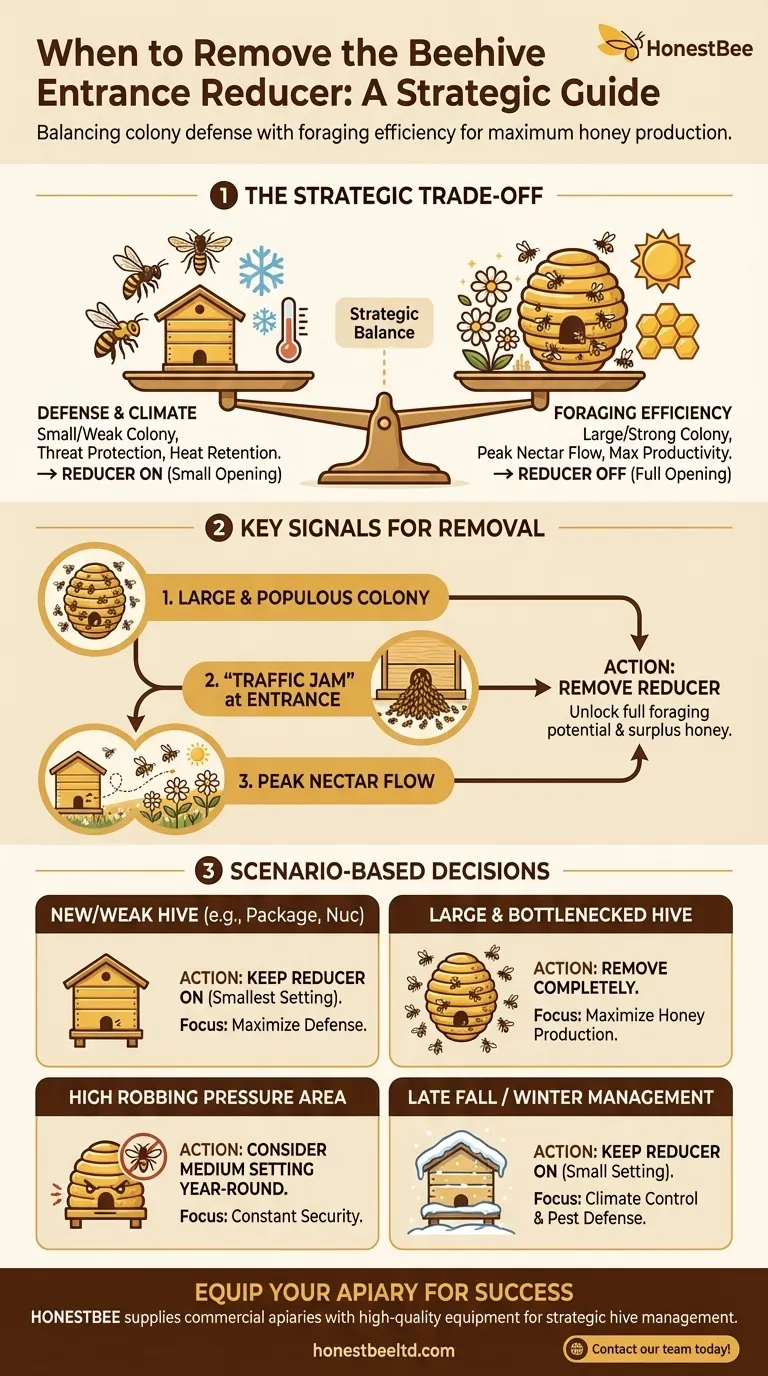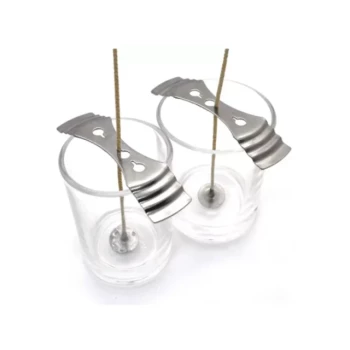In beekeeping, timing is everything, and this is especially true for managing the hive entrance. You should remove the entrance reducer when a large, healthy colony experiences obvious traffic congestion during a strong summer nectar flow. At this point, the colony is populous enough to defend a full-sized entrance, and removing the bottleneck allows foragers to work more efficiently, maximizing honey production.
The decision to remove an entrance reducer is not about a specific date, but a strategic trade-off. You are balancing the colony's need for defense against its need for foraging efficiency. A small, vulnerable hive requires a small, defensible entrance, while a large, booming hive needs an open path to maximize its productivity.

The Primary Role of an Entrance Reducer
An entrance reducer is more than just a block of wood; it's a critical tool for managing your colony's safety and environment, especially in its early stages.
A Matter of Defense
A new or small colony has a limited number of bees available to act as guards. The full entrance of a standard hive is a wide-open door for predators and thieves.
By restricting the entrance size, a reducer creates a defensible chokepoint. This allows a small force of guard bees to effectively repel robber bees from other hives, wasps, and other pests that would otherwise overwhelm and destroy the colony.
A Tool for Climate Control
The reducer also helps the bees manage their internal environment. In the cold of winter, a smaller opening reduces heat loss, helping the cluster stay warm with less effort.
This climate control can also help in summer, assisting with air circulation, though this benefit is secondary to its primary defensive purpose.
Key Signals for Removing the Reducer
Your bees will show you when they are ready for more freedom. The decision to remove the reducer should be based on direct observation, not the calendar.
The Colony is Strong and Populous
The most important prerequisite is a large and healthy bee population. A hive that is packed with bees has a large enough workforce to post sufficient guards to defend a fully open entrance.
You Observe a "Bee Traffic Jam"
The clearest sign is a bottleneck at the entrance. You will see foraging bees forming a "beard" or a cluster on the front of the hive, waiting to get in or out.
This congestion directly hinders the colony's productivity. Every moment a forager waits is a moment it isn't collecting nectar.
The Nectar Flow is at its Peak
The goal of a beekeeper is to have the colony's population peak at the same time as the primary nectar flow. During this period of intense resource availability, the hive's priority shifts from defense to collection.
Removing the reducer at this time unlocks the colony's full foraging potential, allowing them to bring in a surplus of nectar that becomes your honey harvest.
Understanding the Trade-offs
There is no single rule that fits every hive in every location. Understanding the risks and rewards is key to making a sound judgment.
Prioritizing Defense vs. Foraging
Leaving the reducer on, even with a medium-sized opening, is a defensive posture. It ensures the hive remains secure, even if it slightly reduces the maximum rate of foraging.
Removing the reducer completely prioritizes maximum honey production. This is an aggressive move that assumes the colony can handle the increased defensive burden.
The "Year-Round Reducer" Strategy
Some beekeepers, particularly in areas with high robbing pressure, choose to leave the reducer on year-round, often on a medium setting.
This is a valid, conservative strategy. It sacrifices some potential productivity for constant security and peace of mind. For a beginner, this is often the safest approach.
Weather Is a Factor, But Not the Only One
Simple rules like "remove it when you're comfortable in a light sweater" can be misleading. While warmer spring weather signals the start of a colony's buildup, it is not the main reason to remove a reducer.
Colony strength is paramount. Removing the reducer too early on a warm day can leave a still-small colony vulnerable to a sudden robbing attack.
Making the Right Choice for Your Colony
Your decision should always be based on the specific state and needs of your hive. Observe your bees, understand their behavior, and act accordingly.
- If you have a new package, nuc, or weak hive: Keep the entrance reducer on the smallest opening to maximize defense while the colony builds its population.
- If your colony is large and you see foragers bottlenecking at the entrance: Remove the reducer completely to maximize honey production during a strong nectar flow.
- If you are managing hives in late fall and winter: Use the reducer to help the colony retain heat and defend against mice and other overwintering pests.
- If you prefer a cautious, low-intervention approach: Keep the reducer on a medium or small setting year-round, accepting a potential reduction in peak foraging for constant security.
Trust your observations of the colony's strength and activity; they are your most reliable guide.
Summary Table:
| Scenario | Action | Key Reason |
|---|---|---|
| New, weak, or overwintering hive | Keep reducer on (smallest setting) | Maximize defense & climate control |
| Large, strong colony with bee traffic jams | Remove reducer completely | Maximize foraging efficiency & honey production |
| High robbing pressure area | Consider reducer on medium setting year-round | Prioritize constant security |
Ready to equip your apiary for maximum productivity?
At HONESTBEE, we supply commercial apiaries and beekeeping equipment distributors with the high-quality, durable supplies needed to make strategic hive management decisions with confidence. From entrance reducers to full hive setups, our wholesale-focused operations ensure you get the reliable equipment your business depends on.
Let's discuss your needs and how we can support your success. Contact our team today!
Visual Guide

Related Products
- Multi-Functional Rotary Hive Entrance Disc for Beekeeping
- Multi-Functional Sliding Hive Entrance for Beekeeping
- HONESTBEE Advanced Ergonomic Stainless Steel Hive Tool for Beekeeping
- HONESTBEE Professional Long Handled Hive Tool with Precision Cutting Blade
- Professional Insulated Winter Hive Wrap for Beekeeping
People Also Ask
- What control does the circular metal beehive entrance disc provide? Master Hive Access & Bee Health
- What does a fully open setting on a round beehive entrance disc allow? Maximize Foraging & Ventilation
- How does entrance configuration vary seasonally for beekeepers? A Guide to Year-Round Hive Health
- How does the outer cover create an upper entrance? Master Hive Ventilation & Congestion Control
- What are the four entrance options provided by the steel entrance disc? Master Hive Traffic & Protection



















